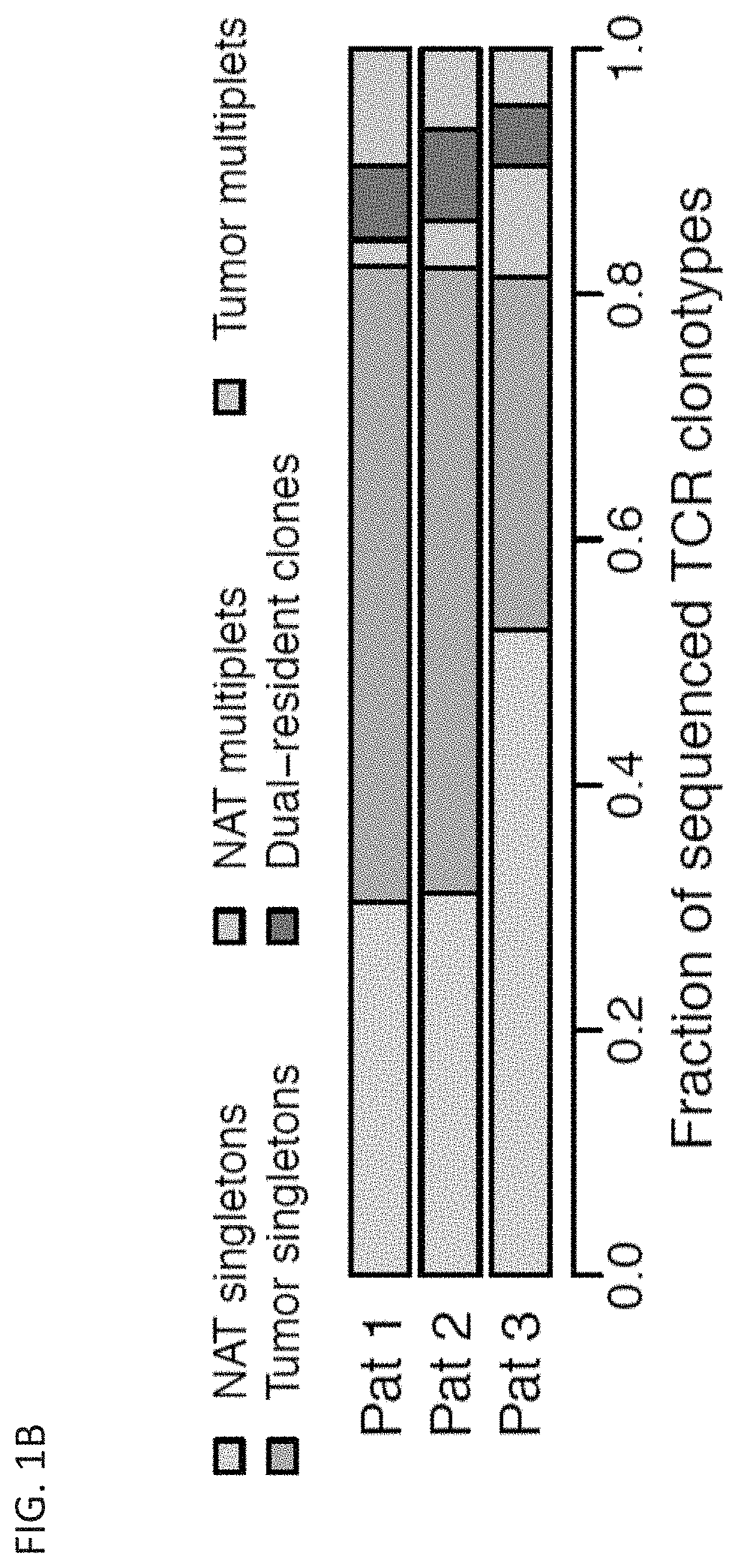Diagnostic methods and compositions for cancer immunotherapy
a cancer immunotherapy and diagnostic method technology, applied in the direction of immunoglobulins, drug compositions, peptides against animals/humans, etc., can solve the problems of difficult detection and timely treatment of cancer, and remain one of the most deadly threats to human health, so as to improve the responsiveness to treatment with the pdl1 axis binding antagonist
- Summary
- Abstract
- Description
- Claims
- Application Information
AI Technical Summary
Benefits of technology
Problems solved by technology
Method used
Image
Examples
example 1
pansion Modes in Tumor Microenvironments and Normal Adjacent Tissue Correlate with Distinct Gene Expression Patterns
[0776]Upon encountering their cognate antigens, T cells can undergo clonal expansion to produce multiple copies of a cell with a shared T cell receptor (TCR). Despite the fundamental role of clonal expansion in cancer immunity, little is known about its relationship with T cell subpopulations or antitumor responses in cancer patients. This example describes experiments in which TCRs and RNA were sequenced from single CD3+ T cells from primary non-small cell lung cancer and matched normal adjacent tissues (NAT). The data obtained from these studies demonstrate that, although most clonotypes were represented by a single cell, the remaining clonal lineages showed expansion in either NAT or tumor exclusively, or dual-residence with expansion in both compartments. Activated CD4+ T cells exhibited NAT expansion; resident memory T cells exhibited tumor expansion; cytotoxic T ...
example 2
hip Between Gene Expression Patterns and Responsiveness to PD-L1 Axis Binding Antagonist Therapy
[0837]Across the TIL populations of the three patients analyzed in Example 1, variability was observed in the proportions of both clonal residency patterns (FIG. 1D) and T cell subsets. Especially apparent were differing fractions of Tcyt, Tem, and NKT cells across patients (FIG. 5A). It was thus explored whether gene expression patterns among TIL populations might be associated with clinical response to PD-L1 axis binding antagonist therapy, such as atezolizumab. To this end, gene set enrichment analysis (GSEA) (Subramanian, A. et al. Proc Natl Acad Sci USA 102, 15445-15550, 2005; and Lamb, J. et al. Science 313, 1929-1935, 2006) was applied to pre-treatment bulk tumor RNA-seq data from a randomized phase II clinical trial (POPLAR, (Fehrenbacher, L. et al. Lancet 387, 1837-1846 (2016))) that compared the anti-PD-L1 antibody atezolizumab with the chemotherapeutic agent docetaxel in 193 pa...
example 3
ng the Propensity of a Patient to Respond to PD-L1 Axis Binding Antagonist Therapy and Treatment of the Patient Accordingly
[0855]Using the compositions and methods described herein, the likelihood that a patient having a cancer will be responsive to PD-L1 axis binding antagonist therapy can be determined. For example, a patient having a cancer described herein, such as lung cancer (e.g., non-small cell lung cancer), bladder cancer (e.g., urothelial carcinoma), kidney cancer (e.g., renal cell carcinoma), or breast cancer (e.g., triple-negative breast cancer) may be subjected to one or more gene expression assays in order to determine whether the patient is likely to respond to treatment including a PD-L1 axis binding antagonist (e.g., PD-L1 binding antagonist (e.g., anti-PD-L1 antibody, e.g., atezolizumab (MPDL3280A)) or PD-1 binding antagonist (e.g., anti-PD-1 antibody)). To make this determination, a physician may determine the expression level of one or more of genes CST7, NKG7, G...
PUM
| Property | Measurement | Unit |
|---|---|---|
| Fraction | aaaaa | aaaaa |
| Time | aaaaa | aaaaa |
| Length | aaaaa | aaaaa |
Abstract
Description
Claims
Application Information
 Login to View More
Login to View More - R&D
- Intellectual Property
- Life Sciences
- Materials
- Tech Scout
- Unparalleled Data Quality
- Higher Quality Content
- 60% Fewer Hallucinations
Browse by: Latest US Patents, China's latest patents, Technical Efficacy Thesaurus, Application Domain, Technology Topic, Popular Technical Reports.
© 2025 PatSnap. All rights reserved.Legal|Privacy policy|Modern Slavery Act Transparency Statement|Sitemap|About US| Contact US: help@patsnap.com



